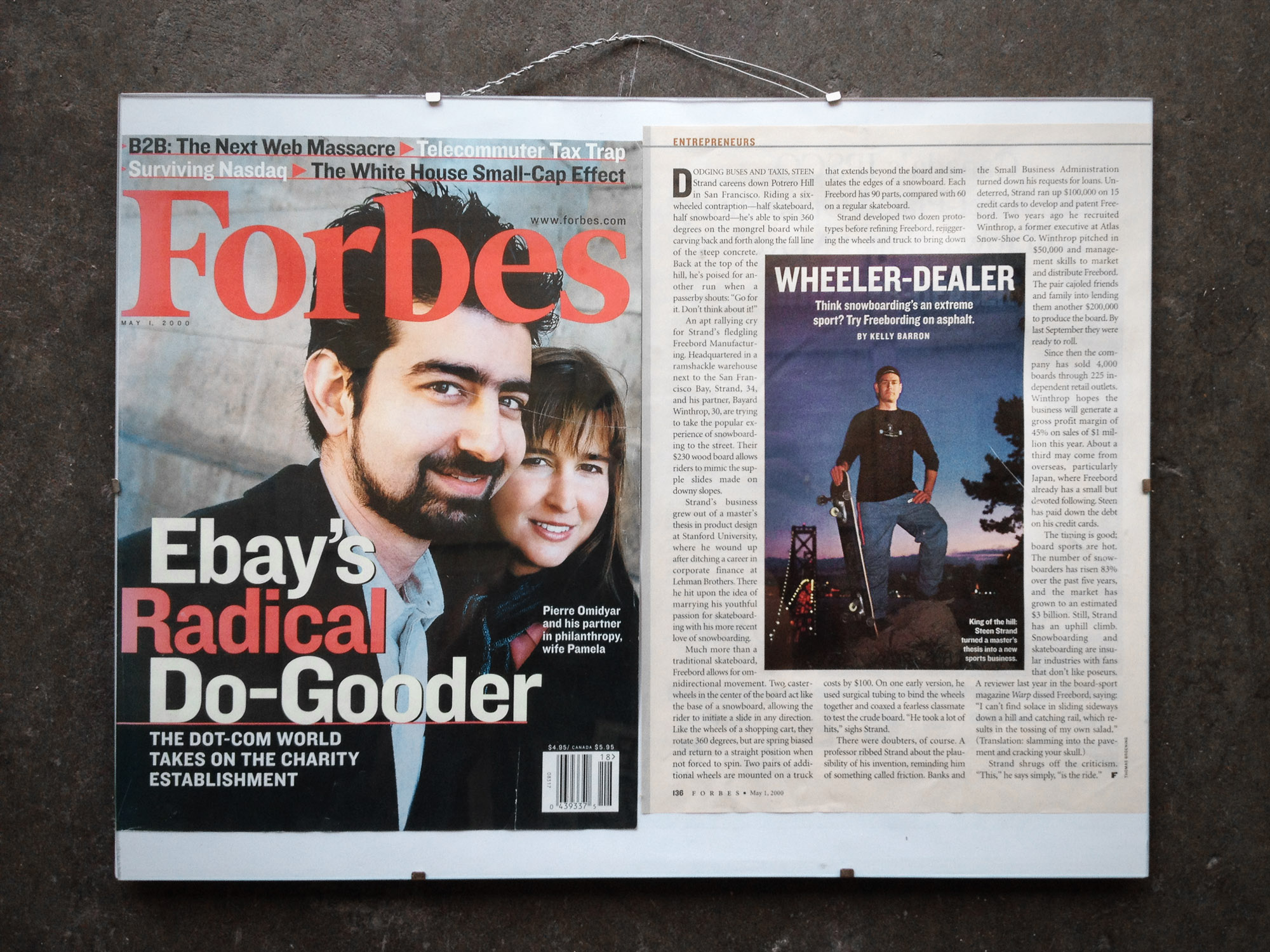Forbes does Freebord
Check out Freebord in today’s Throwback Thursday circa 2000, featuring Steen Strand in Forbes Magazine; complete article below.
Article Link
Wheeler-Dealer
Dodging buses and taxis, Steen Strand careens down Potrero Hill in San Francisco. Riding a six-wheeled contraption–half skateboard, half snowboard–he’s able to spin 360 degrees on the mongrel board while carving back and forth along the fall line of the steep concrete. Back at the top of the hill, he’s poised for another run when a passerby shouts: “Go for it. Don’t think about it!”
An apt rallying cry for Strand’s fledgling Freebord Manufacturing. Headquartered in a ramshackle warehouse next to the San Francisco Bay, Strand, 34, and his partner, Bayard Winthrop, 30, are trying to take the popular experience of snowboarding to the street. Their $230 wood board allows riders to mimic the supple slides made on downy slopes.
Strand’s business grew out of a master’s thesis in product design at Stanford University, where he wound up after ditching a career in corporate finance at Lehman Brothers. There he hit upon the idea of marrying his youthful passion for skateboarding with his more recent love of snowboarding.
Much more than a traditional skateboard, Freebord allows for omnidirectional movement. Two casterwheels in the center of the board act like the base of a snowboard, allowing the rider to initiate a slide in any direction. Like the wheels of a shopping cart, they rotate 360 degrees, but are spring biased and return to a straight position when not forced to spin. Two pairs of additional wheels are mounted on a truck that extends beyond the board and simulates the edges of a snowboard. Each Freebord has 90 parts, compared with 60 on a regular skateboard.
Strand developed two dozen prototypes before refining Freebord, rejiggering the wheels and truck to bring down costs by $100. On one early version, he used surgical tubing to bind the wheels together and coaxed a fearless classmate to test the crude board. “He took a lot of hits,” sighs Strand.
“This,” he says simply, “is the ride.”
There were doubters, of course. A professor ribbed Strand about the plausibility of his invention, reminding him of something called friction. Banks and the Small Business Administration turned down his requests for loans. Undeterred, Strand ran up $100,000 on 15 credit cards to develop and patent Freebord. Two years ago he recruited Winthrop, a former executive at Atlas Snow-Shoe Co. Winthrop pitched in $50,000 and management skills to market and distribute Freebord. The pair cajoled friends and family into lending them another $200,000 to produce the board. By last September they were ready to roll.
Since then the company has sold 4,000 boards through 225 independent retail outlets. Winthrop hopes the business will generate a gross profit margin of 45% on sales of $1 million this year. About a third may come from overseas, particularly Japan, where Freebord already has a small but devoted following. Steen has paid down the debt on his credit cards.
The timing is good; board sports are hot. The number of snowboarders has risen 83% over the past five years, and the market has grown to an estimated $3 billion. Still, Strand has an uphill climb. Snowboarding and skateboarding are insular industries with fans that don’t like poseurs. A reviewer last year in the board-sport magazine Warp dissed Freebord, saying: “I can’t find solace in sliding sideways down a hill and catching rail, which results in the tossing of my own salad.” (Translation: slamming into the pavement and cracking your skull.)
Strand shrugs off the criticism. “This,” he says simply, “is the ride.”
by Kelly Barron


cool. i saw this in the factory but never actually read the article. good stuff